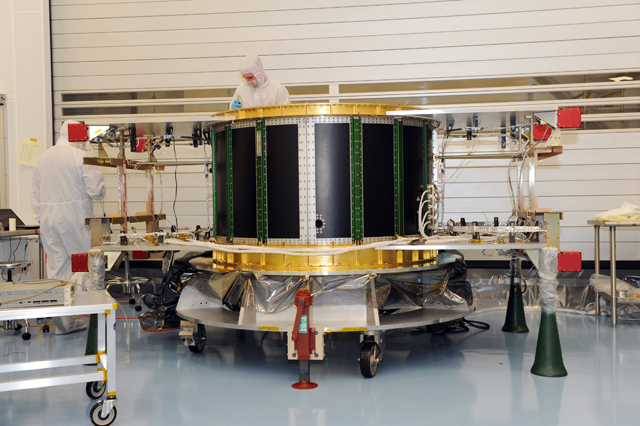Photo Credit: NASA, http://mms.gsfc.nasa.gov/observatory_integration/obs3/obs3_08.html
MMS will do something unique: it studies how the Earth's and Sun's magnetic fields connect and disconnect, and as a result transfer energy to Earth and other planets in a process called reconnection. MMS uses 4 identical spacecrafts spaced in Earth's orbit, to obtain 3-dimensional data of the magnetospheric boundary to study this process. MMS uses the Earth's magnetosphere as a natural laboratory that can be directly studied.
MMS is being built in NASA Goddard Space Flight Center and is currently scheduled to launch in October 2014. The mission is similar to ESA's Cluster mission with more spatial and temporal resolution, allowing to study the electron diffusion region.
References:
[1] Magnetospheric Multiscale (MMS) Mission.
[2] http://www.nasa.gov/centers/goddard/news/topstory/2009/mms_magnetic.html
[3] http://mms.gsfc.nasa.gov/about_mms.html
[4] http://en.wikipedia.org/wiki/Magnetospheric_Multiscale_Mission
[5] http://en.wikipedia.org/wiki/Cluster_mission

Hi Nargess, sorry for my ignorance, but when you write about "...interaction of the earth and suns's magnetic fields...", then how can we imagine this ? The earth magnetic field is a meta-stable system, whith the two poles on the norther and on the southern artic/antartic area. But I always understoud that the solars magnetic field is much more complex, or say chaotic, with many poles spread around the suns surface, in particular near the sun spots. How can these two types of fields interact ? And isn't the field strength over this large distance much to weak for any interaction, at least as compared to the gravitational force between earth and sun ? And if such interaction is relevant, are there some particular phenomenon here on earth that are caused by this (like the solar winds interaction with the earth magnetic field causes northern lights, or like the moon gravitational force onto earth causes the tides, or solar flares causing some electronic dropouts on terrestrial communication) ?
ReplyDeleteI hope you can explain this.
best regards
Michael
Hi Michael,
ReplyDeleteSorry for my late reply, I have been extremely busy. Unfortunately I am not a physicists and do not know much about this topic. However, this video and its animations of the concepts, may help you better visualize what MMS will study:
http://www.youtube.com/watch?v=BkS5Xh8wW-8
I hope this helps.
I did had a look at the mechanism that the MMS mission is about to investigate. Its called Magnetic Field Reconnection (MFR), and I have to admit that although having studied physics, I never heard about this before (or forgot already). The effects of this phenomenon in the earth- and sun's magnetic fields must be tiny, since the field strength over this hugh distance is almost immeasurable.
ReplyDeleteBut it is assumed that in the projected fusion reactors of the tokamak type this MFR is very relevant and responsible for instabilities of the plasma reaction.
Michael
Thanks for the information.
ReplyDelete